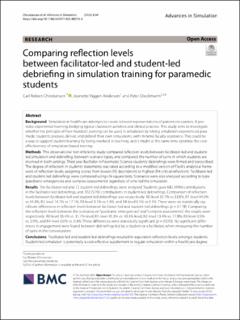| dc.contributor.author | Andersen, Jeanette Viggen | |
| dc.contributor.author | Dieckmann, Gerhard Peter | |
| dc.contributor.author | Christiansen, Carl Robert | |
| dc.date.accessioned | 2024-04-08T11:30:03Z | |
| dc.date.available | 2024-04-08T11:30:03Z | |
| dc.date.created | 2023-12-15T08:22:10Z | |
| dc.date.issued | 2023 | |
| dc.identifier.citation | Christiansen, C.R., Andersen, J.V. & Dieckman, P. (2023) Comparing reflection levels between facilitator-led and student-led debriefing in simulation training for paramedic students. Advances in Simulation, 8, 30 (2023) | en_US |
| dc.identifier.issn | 2059-0628 | |
| dc.identifier.uri | https://hdl.handle.net/11250/3125273 | |
| dc.description.abstract | Background
Simulation in healthcare attempts to create relevant representations of patient encounters. It provides experiential learning, bridging typical classroom activities and clinical practice. This study aims to investigate whether the principle of Peer-Assisted Learning can be used in simulation by letting simulation-experienced paramedic students prepare, deliver, and debrief their own simulations, with minimal faculty assistance. This could be a way to support student learning by being involved in teaching, and it might at the same time optimise the cost-effectiveness of simulation-based training.
Methods
This observational non-inferiority study compared reflection levels between facilitator-led and student-led simulation and debriefing, between scenario types, and compared the number of turns in which students are involved in both settings. Third-year Bachelor in Paramedic Science students’ debriefings were filmed and transcribed. The degree of reflection in students’ statements was rated according to a modified version of Fleck’s analytical framework of reflection levels, assigning scores from lowest (R0 description) to highest (R4 critical reflection). Facilitator-led and student-led debriefings were compared using chi-square tests. Scenarios were also analysed according to type (paediatric emergencies and complex assessments) regardless of who led the simulation.
Results
Ten facilitator-led and 12 student-led debriefings were analysed. Students gave 682 (49%) contributions in the facilitator-led debriefings, and 702 (51%) contributions in student-led debriefings. Comparison of reflection levels between facilitator-led and student-led debriefings was respectively: R0-level 32.7% vs 33.8%, R1-level 44.0% vs 44.3%, R2-level 14.7% vs 17.1%, R3-level 0.1% vs 1.3%, and R4-level 0.1% vs 0.1%. There were no statistically significant differences in reflection levels between facilitator-led and student-led debriefings (p = 0.178). Comparing the reflection levels between the scenarios on “paediatric emergencies” and “complex assessments”, the results were respectively: R0-level 35.4% vs. 31.7%-level, R1-level 45.3% vs. 43.3%-level, R2-level 13.4% vs. 17.8%, R3-level 0.5% vs. 0.9%, and R4-level 0.0% vs. 0.3%. These differences were statistically significant (p = 0.010). No significant differences in engagement were found between debriefings led by a student or a facilitator, when measuring the number of turns in the conversations.
Conclusions
Facilitator-led and student-led debriefings resulted in equivalent reflection levels amongst students. Student-led simulation is potentially a cost-effective supplement to regular simulation within a healthcare degree program. Since complex scenarios provided higher reflection levels than paediatric, scenario design might influence reflection levels. | en_US |
| dc.language.iso | eng | en_US |
| dc.publisher | BioMed Central | en_US |
| dc.rights | Navngivelse 4.0 Internasjonal | * |
| dc.rights.uri | http://creativecommons.org/licenses/by/4.0/deed.no | * |
| dc.subject | paramedisin | en_US |
| dc.subject | simuleringsbasert opplæring | en_US |
| dc.subject | simuleringsbasert trening | en_US |
| dc.title | Comparing reflection levels between facilitator-led and student-led debriefing in simulation training for paramedic students | en_US |
| dc.type | Peer reviewed | en_US |
| dc.type | Journal article | en_US |
| dc.description.version | publishedVersion | en_US |
| dc.rights.holder | © 2023 The Author(s). | en_US |
| dc.subject.nsi | VDP::Medisinske Fag: 700::Helsefag: 800 | en_US |
| dc.source.volume | 8 | en_US |
| dc.source.journal | Advances in Simulation | en_US |
| dc.identifier.doi | 10.1186/s41077-023-00273-0 | |
| dc.identifier.cristin | 2213924 | |
| dc.source.articlenumber | 30 (2023) | en_US |
| cristin.ispublished | true | |
| cristin.fulltext | original | |
| cristin.qualitycode | 1 | |

